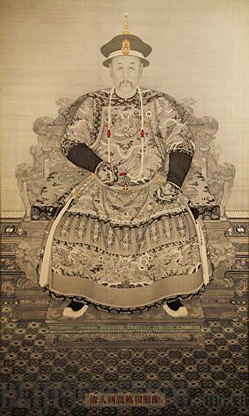|
 |
 |
|
A portrait of Emperor Yong Zheng (1678-1735) of the Qing Dynasty (CFP) |
A royal stamp of the Qing Dynasty (Wu JINGTENG) |
For the first time in history, curators of the Palace Museum have finally inventoried the museum's vast collection. After seven years of painstaking work, the museum finally released the results of its first comprehensive inventory on January 26, showing that the museum houses 1,807,558 items.
About 93 percent of the museum's collection are national-level protected cultural relics. An additional 115,491 items are ordinary cultural relics, while 7,577 items are pieces of royal porcelain.
"This is the fifth survey of the treasures in the museum, but it is the first time that the museum has established exactly how many pieces of treasure it houses since the museum was founded on October 10, 1925," said Chen Lihua, Deputy Curator of the museum.
Bits of treasure
"The most remarkable point of this survey is about the articles for daily use of the royal members," said Chen.
Eighty-five percent of the items in the museum are imperial pieces from the Qing Dynasty (1644-1911), including bronze ware, timepieces, jade, ceramics, paintings and calligraphy, historical documents and ancient books.
In the past, articles used by emperors and empresses in their daily lives were not considered to be cultural relics. Thus, about 700,000 such items were previously treated as common objects; and some helmets and pieces of armor were therefore moved out of the palace. Since the 1980s, museum experts began to rethink this procedure. They felt these objects were as valuable as historic buildings and other cultural relics. Paintings by emperors and empresses, carpets, pillows, curtains and waist tags of guards and so on were recorded in the museum's treasure list for the first time in the museum's 85-year history.
"For a long time, the Palace Museum was only regarded as a museum of ancient art, thus people didn't pay much attention to objects used by the imperial court in their daily lives. For example, paintings of royal family members are generally not of great artistic value; therefore, they were not seriously treated and protected. However, from another perspective, those paintings can truly reflect the daily life of the royal family and the artistic ideas of royalty," said Lou Wei, head of the cultural relic department of the Palace Museum.
The latest survey was conducted at the same time as the renovation of the historic buildings of the Forbidden City, where the Palace Museum is located. The renovation is supposed to be completed in 2020. The first stage of the project was finished in 2008.
During the process of survey and renovation, storerooms for the treasures were upgraded. Equipment and conditions for storage and maintenance have been improved, and earthquake-resistant systems have been upgraded. At the same time, the management system of the museum was also greatly improved.
Five surveys
Since the museum experienced several periods of social unrest in its history, it never completed a comprehensive inventory of its collection before. Earlier partial surveys were undertaken in 1924, 1954, 1978 and 1991, respectively.
After the first survey, which was completed in 1930, a 28-volume survey report was compiled cataloguing more than 1.17 million items housed in the museum.
In the 1930s, when the Japanese army invaded northeast China, the museum's treasures were moved south. Before the People's Republic of China was founded in 1949, the Kuomintang authorities moved part of those treasures to Taiwan, and the Palace Museum in Taipei was established to house the treasures. It is reported that about 650,000 treasures were stored in Taipei.
The second survey of the museum's collection was carried out in 1954, the first survey after the founding of New China. By then the collection of the museum had changed considerably. On one hand, some treasures had been moved to Taiwan; on the other hand, many treasures were donated to the museum by private collectors and state organs or were recovered from other locations. At that time, the collection of the museum accounted for about 14.3 percent of all collected cultural relics in China.
| 